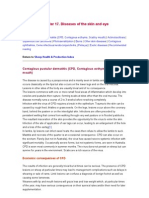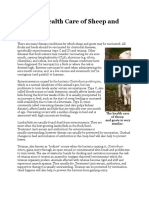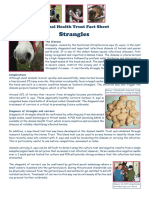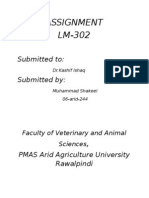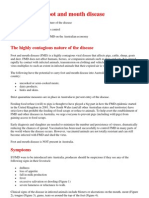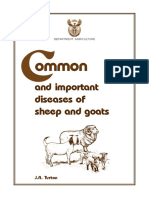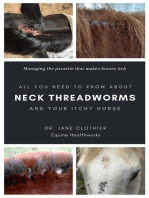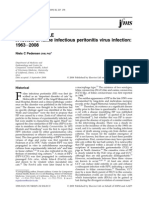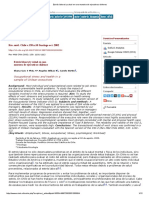Scabby Mouth (Orf) - A Disease of Sheep and Goats
Scabby Mouth (Orf) - A Disease of Sheep and Goats
Uploaded by
SteliosMavromatisCopyright:
Available Formats
Scabby Mouth (Orf) - A Disease of Sheep and Goats
Scabby Mouth (Orf) - A Disease of Sheep and Goats
Uploaded by
SteliosMavromatisOriginal Title
Copyright
Available Formats
Share this document
Did you find this document useful?
Is this content inappropriate?
Copyright:
Available Formats
Scabby Mouth (Orf) - A Disease of Sheep and Goats
Scabby Mouth (Orf) - A Disease of Sheep and Goats
Uploaded by
SteliosMavromatisCopyright:
Available Formats
Scabby mouth (orf) - a disease of
sheep and goats
September 2002
AG1015
ISSN 1329-8062
Revised by Dr. Susan Bibby, Bendigo from an original publication by Dr. Tony
Brightling.
Scabby mouth (contagious ecthyma, orf) is a highly
contagious, viral disease of sheep, goats and occasionally
humans. It occurs throughout Victoria. This disease is a
potential problem of live sheep exports due to the close
confinement of animals and the feeding of sheep with
pellets and hay that cause minor abrasions to the mouth
and lips.
are unsightly and do affect the consistency and quality of
the product reaching overseas markets.
Method of infection
The scabby mouth virus infects a sheep through abrasions
in the skin. Cool, non-woolled areas such as the mouth,
legs, feet, teats and poll are the usual sites of infection.
Sheep grazing stubble or on harsh feed are most
susceptible to scabby mouth infection due to a higher
incidence of minor injuries of the mouth and feet.
Signs
The mouth and feet are most commonly affected. At first
small, reddened areas appear and begin to weep a clear
fluid. This fluid eventually hardens into a thick brown
scab. In the early stages the scab is firmly attached and if
forcibly removed, a raw bleeding area is exposed. After
two to three weeks the scabs dry up and drop off. The
underlying skin then heals rapidly.
Spread within the flock is usually rapid. In most cases the
scabs appear at the corner of the mouth and muzzle (see
figure 1). In severe cases they cover the lips and spread
into the mouth and nostrils. Occasionally scabs occur
around the eyes. Scabs on the legs usually occur on the
fetlock or coronet (see figure 2). Scabs can also develop
on the udder and teats of ewes. Affected ewes may not
allow lambs to suckle resulting in lamb losses and reduced
weight gain, and affected lambs may find it difficult to feed
or suckle normally. Mastitis may also be a problem in a
proportion of ewes.
A diagnosis of scabby mouth can be confirmed by
laboratory examination of the scabs by electron
microscopy but this is rarely necessary.
Sheep on board live sheep boats do not develop scabs as
extensively as sheep in the paddock, however the lesions
State of Victoria, Department of Primary Industries
Figure 1. Scabs at the corner of the mouth and muzzle
Figure 2. An area above the hoof of a young lamb affected by
scabby mouth virus
Control
Animals that recover from scabby mouth develop a life
long immunity to the disease. Sheep of all ages may
become affected during the first outbreak on the property,
but in subsequent years usually only the lambs are affected.
A scabby mouth vaccine is readily available and provides
good protection from the disease. The vaccine is applied
Page 1
Scabby mouth (orf) - a disease of sheep and goats
to the bare skin on the inside of the thigh by scratching
with a forked needle that has been dipped in vaccine. This
causes a local reaction that does not spread. A line of
pustules should appear along the scratch a week later this
indicates a good response and immunity from the vaccine.
A sample of vaccinated sheep (about 10 per mob) should
be checked between ten and fourteen days after
vaccination to ensure a good take.
The recommended program for a property with continuing
scabby mouth problems is to vaccinate each years drop of
lambs. This can be done at marking and will provide
protection for up to 18 months. Sheep intended for live
trade with the Middle East may require another vaccination
before export.
The disease in humans
Humans occasionally become infected with the scabby
mouth virus. The disease in man is called orf. The usual
signs in humans are red papules, which are most often on
the hands or arms. Shearers are sometimes affected in the
armpit as a result of holding affected feet under their arms.
Humans may also become infected from accidental
inoculation of the scabby mouth vaccine. Care should be
taken to cover scratches and cuts before using the vaccine,
and to not accidentally scratch fingers or hands with the
vaccine applicator.
AG1015
Treatment
The disease in sheep and goats is normally self-limiting,
and clears without treatment within three to four weeks.
Early manual removal of scabs will delay healing.
Antibiotics are not necessary, unless secondary bacterial
infection occurs.
Scabby mouth sores on the legs are susceptible to fly
strike. These leg lesions are most common in good
seasons, when the legs are constantly exposed to long, wet
pasture. The skin becomes macerated, and the virus then
enters causing large scabby plaques. Leg and foot lesions
may also occur when sheep graze stubble paddocks and the
skin is damaged by the sharp stalks remaining after the
crop has been harvested. Affected sheep may be protected
against fly strike by walking them through a footbath of
jetting solution. Sheep with scabs around the mouth
should be supplied with soft, lush feed to allow easier
grazing, and to reduce trauma to the scabs while they heal.
Further information
Further information on scabby mouth vaccination
programs can be obtained from your local Animal Heath
and Welfare staff, or the Customer Service Centre on 136
186.
The advice provided in this publication is intended as a source of information only. Always read the label before using any of the products
mentioned. The State of Victoria and its employees do not guarantee that the publication is without flaw of any kind or is wholly appropriate for
your particular purposes and therefore disclaims all liability for any error, loss or other consequence which may arise from you relying on any
information in this publication.
State of Victoria, Department of Primary Industries
Page 2
You might also like
- An Atlas and Manual of Cephalometric RadiographyDocument224 pagesAn Atlas and Manual of Cephalometric RadiographytonhanrhmNo ratings yet
- Introduction To TelemedicineDocument25 pagesIntroduction To TelemedicineVaibhav SinhaNo ratings yet
- Last Minute Notes For USMLE Step 2CKDocument16 pagesLast Minute Notes For USMLE Step 2CKJonathan B. Michaels100% (1)
- Hard KnocksDocument5 pagesHard KnocksgabrielcharlesytylerNo ratings yet
- CMW Administrative Supervisory Checklist - AAP-Health-MNCHDocument5 pagesCMW Administrative Supervisory Checklist - AAP-Health-MNCHRehmatullahNo ratings yet
- Common Diseases of Goat and SheepDocument14 pagesCommon Diseases of Goat and SheepFrancine MaramagNo ratings yet
- Goat Health Caseous Lymphadenitis Cheesy GlandDocument2 pagesGoat Health Caseous Lymphadenitis Cheesy GlandDr.Sameer ShendreNo ratings yet
- Goat Cheesy GlandDocument3 pagesGoat Cheesy GlandSidonSaagarVincentNo ratings yet
- Chapter 17Document6 pagesChapter 17api-3712408No ratings yet
- Animal Science Lab 5 SheepDocument5 pagesAnimal Science Lab 5 Sheepapi-355974802100% (1)
- Skin Skin Skin Skin Skin Conditions Conditions Conditions Conditions Conditions in Pigs in Pigs in Pigs in Pigs in PigsDocument10 pagesSkin Skin Skin Skin Skin Conditions Conditions Conditions Conditions Conditions in Pigs in Pigs in Pigs in Pigs in PigsClaritha TaopanNo ratings yet
- Rabbit Skin Parasites 2002Document9 pagesRabbit Skin Parasites 2002CabrasDeVillaraureNo ratings yet
- Lumpy-Skin Disease: A Disease of Socio-Economic ImportanceDocument8 pagesLumpy-Skin Disease: A Disease of Socio-Economic ImportanceMaged LamiyNo ratings yet
- I. Foot and Mouth DiseaseDocument19 pagesI. Foot and Mouth DiseaseSpermaNo ratings yet
- Pigeon DiseasesDocument20 pagesPigeon DiseaseskumarKaushal784No ratings yet
- Common Diseases of Backyard PoultryDocument3 pagesCommon Diseases of Backyard PoultrynawazdakhveNo ratings yet
- Contagious Ecthyma: Orf, Contagious Pustular Dermatitis, Sore Mouth, Scabby MouthDocument27 pagesContagious Ecthyma: Orf, Contagious Pustular Dermatitis, Sore Mouth, Scabby MouthMohammedNo ratings yet
- Management of Grower-Finisher PigsDocument23 pagesManagement of Grower-Finisher Pigsbstudent136No ratings yet
- Footrot PDFDocument3 pagesFootrot PDFFarhanNo ratings yet
- 3.FMD - BASIC - Isloor - 27.02.2024 - 020550-CompressedDocument92 pages3.FMD - BASIC - Isloor - 27.02.2024 - 020550-CompressedpriyaNo ratings yet
- Swine Production PPT-2Document98 pagesSwine Production PPT-2The Municipal Agriculturist100% (1)
- General Health Care of Sheep and Goats: VaccinationsDocument5 pagesGeneral Health Care of Sheep and Goats: VaccinationsSuresh Kumar UNo ratings yet
- Parasites: Argentina and B. Bigemini Have Been Reported in Feral BuffaloesDocument8 pagesParasites: Argentina and B. Bigemini Have Been Reported in Feral BuffaloesEDGAR ARTURO TORRES GOMEZNo ratings yet
- Foot and Mouth DiseaseDocument93 pagesFoot and Mouth DiseaseVer Garcera Talosig100% (1)
- Foot and Mouth Disease - Department of Agriculture, Environment and Rural AffairsDocument6 pagesFoot and Mouth Disease - Department of Agriculture, Environment and Rural AffairsAmon Jnr KamungarangaNo ratings yet
- Swine Diseasesaldrin PptDocument32 pagesSwine Diseasesaldrin PptSandra EspinosaNo ratings yet
- Large Ruminant DiseasesDocument96 pagesLarge Ruminant DiseasesJayson Basiag100% (1)
- Strangles SheetDocument2 pagesStrangles Sheetapi-306398192No ratings yet
- L4. Rabbit Parasitic DiseasesDocument12 pagesL4. Rabbit Parasitic DiseasesAya HagagNo ratings yet
- Ear Tip NecrosisDocument7 pagesEar Tip NecrosisMatthew HsuNo ratings yet
- TLE 8 Q3W8 Animal ProdDocument8 pagesTLE 8 Q3W8 Animal Prodplaq0% (1)
- Common Pig Dise-wps OfficeDocument9 pagesCommon Pig Dise-wps Officedesewayumato26No ratings yet
- Rabbit DiseasesDocument3 pagesRabbit DiseasescioceagabrielNo ratings yet
- Tetanus in Farm AnimalsDocument7 pagesTetanus in Farm AnimalsIsrarNo ratings yet
- Diarrhoea in Sheep and GoatsDocument7 pagesDiarrhoea in Sheep and GoatsobertNo ratings yet
- Assignment Name: Assignment LE 1101 - 2K19 Subject: Leather Manufacturing Technology 1 Course Code: LE 1101 Date of Submission: 22/11/20 From ToDocument21 pagesAssignment Name: Assignment LE 1101 - 2K19 Subject: Leather Manufacturing Technology 1 Course Code: LE 1101 Date of Submission: 22/11/20 From ToHasnain Mohammad HanifNo ratings yet
- +++ Eye Problems in Livestock - Infonet BiovisionDocument10 pages+++ Eye Problems in Livestock - Infonet BiovisionkakunguccNo ratings yet
- 9 Dermatophilosis. Mesele docx (1)Document4 pages9 Dermatophilosis. Mesele docx (1)samrawitsintayehu664No ratings yet
- Assignment LM-302: Submitted To: Submitted byDocument8 pagesAssignment LM-302: Submitted To: Submitted byattahirNo ratings yet
- OtopDocument96 pagesOtopJayzle SaguisiNo ratings yet
- Foot and Mouth Disease: The Highly Contagious Nature of The DiseaseDocument3 pagesFoot and Mouth Disease: The Highly Contagious Nature of The DiseasemalwylieNo ratings yet
- Common Diseases in Goats and SheepDocument16 pagesCommon Diseases in Goats and SheepobertNo ratings yet
- Orf Treatment in AnimalDocument4 pagesOrf Treatment in AnimalArnold MudzengiNo ratings yet
- ScabiesDocument4 pagesScabiesGenita Savitri EkandariNo ratings yet
- Common Mites (Arachnids) of Rabbits Common Mites (Arachnids) of Rabbits and Their Treatment and Their TreatmentDocument8 pagesCommon Mites (Arachnids) of Rabbits Common Mites (Arachnids) of Rabbits and Their Treatment and Their TreatmentMustafarNo ratings yet
- Foot RotDocument5 pagesFoot RotTAMILNo ratings yet
- LESSON 10 Intestinal ParasitesDocument17 pagesLESSON 10 Intestinal Parasitesgimel tenorioNo ratings yet
- Pathology of The Alimentary SystemDocument15 pagesPathology of The Alimentary SystemsatriayanuwardaniNo ratings yet
- Goat Health ManagementDocument4 pagesGoat Health ManagementGlades Maricon P. LigasanNo ratings yet
- Internal Parasites of RabbitsDocument9 pagesInternal Parasites of Rabbitskhanhnp160701No ratings yet
- Rabies Prevention and ControlDocument9 pagesRabies Prevention and ControlJames RiedNo ratings yet
- MorkzzzzDocument22 pagesMorkzzzzjd llobreraNo ratings yet
- Glander DiseaseDocument1 pageGlander DiseaseAdams10No ratings yet
- 14 Deadly Chicken Diseases That Can Destroy Your Poultry InvestmentDocument14 pages14 Deadly Chicken Diseases That Can Destroy Your Poultry InvestmentEBENEMANo ratings yet
- Cattle Common DiseaseDocument13 pagesCattle Common DiseaseTiberiu TudorNo ratings yet
- Background InfoDocument3 pagesBackground Infotbailey1111No ratings yet
- Skin Problem Solutions For Guinea Pigs: Exotics VetsDocument8 pagesSkin Problem Solutions For Guinea Pigs: Exotics VetsSureshJeevanNo ratings yet
- Fowl Pox in Backyard FlocksDocument2 pagesFowl Pox in Backyard FlocksJoynilenge LavadorNo ratings yet
- Vet Preventive Medicine-2Document299 pagesVet Preventive Medicine-2Vishal Khurud50% (2)
- Cutting The Umbilical Cord and Prevention of Tail 2Document9 pagesCutting The Umbilical Cord and Prevention of Tail 2airamariem.valeraNo ratings yet
- VM13400 StranglesDocument4 pagesVM13400 StranglesAbraham Carrasco MaldonadoNo ratings yet
- 911 Pigeon Disease & Treatment Protocols!From Everand911 Pigeon Disease & Treatment Protocols!Rating: 4 out of 5 stars4/5 (1)
- Notes on Diseases of Cattle: Cause, Symptoms and TreatmentFrom EverandNotes on Diseases of Cattle: Cause, Symptoms and TreatmentNo ratings yet
- All You Need to Know About Neck Threadworms and Your Itchy HorseFrom EverandAll You Need to Know About Neck Threadworms and Your Itchy HorseNo ratings yet
- Diseases of Swine - How to Know Them, Their Causes, Prevention and Cure - Containing Extracts from Livestock for the Farmer and Stock OwnerFrom EverandDiseases of Swine - How to Know Them, Their Causes, Prevention and Cure - Containing Extracts from Livestock for the Farmer and Stock OwnerNo ratings yet
- A Review of Feline Infectious Peritonitis Virus Infection - 1963-2008Document34 pagesA Review of Feline Infectious Peritonitis Virus Infection - 1963-2008Hospital Veterinário e Pet Shop Dr. HatoNo ratings yet
- Canine BabesiosisDocument10 pagesCanine BabesiosisIonuț Gabriel ȚoleaNo ratings yet
- Inspection of Biotech ManufacturersDocument13 pagesInspection of Biotech ManufacturersHimabindu UppukonduriNo ratings yet
- Esi Covering LetterDocument64 pagesEsi Covering LetterkanchanNo ratings yet
- Delorenzi 2017Document3 pagesDelorenzi 2017Marilia RezendeNo ratings yet
- opt manual - 纯白Document22 pagesopt manual - 纯白Seleccion HumanosNo ratings yet
- 14 Clauss Pediatric Echocardiography PDFDocument159 pages14 Clauss Pediatric Echocardiography PDFSergiu NiculitaNo ratings yet
- Estrés Laboral y Salud en Una Muestra de Ejecutivos ChilenosDocument12 pagesEstrés Laboral y Salud en Una Muestra de Ejecutivos ChilenosAndrea MiñoNo ratings yet
- Audit Alcohol QuestionnaireDocument2 pagesAudit Alcohol QuestionnaireaberosnerNo ratings yet
- BecomeSuperhumanResourceGuide BenGreenfieldDocument46 pagesBecomeSuperhumanResourceGuide BenGreenfieldIacopoMariaFilippoBarni100% (5)
- Pediatric Dyalisis Cases Book WaradyDocument339 pagesPediatric Dyalisis Cases Book WaradyCinthya Quispe FernandezNo ratings yet
- Surgical Correction of Childhood Intermittent Exotropia and The Risk of Developing Mental IllnessDocument6 pagesSurgical Correction of Childhood Intermittent Exotropia and The Risk of Developing Mental IllnessnysNo ratings yet
- Ramesh Chandra Agarwal Vs Regency Hospital LTD SC 2009 Expert Opinion Can Not Be Accepted Without ExaminationDocument18 pagesRamesh Chandra Agarwal Vs Regency Hospital LTD SC 2009 Expert Opinion Can Not Be Accepted Without ExaminationYatn BangadNo ratings yet
- ETC1010 Paper 1Document9 pagesETC1010 Paper 1wjia26No ratings yet
- Syllabus Nts 08 24 FinalDocument23 pagesSyllabus Nts 08 24 Finaljitendra singhNo ratings yet
- Images Elizabeth City: 2012Document53 pagesImages Elizabeth City: 2012Journal CommunicationsNo ratings yet
- DR Rabbit and Friends Collection of Song LyricsDocument19 pagesDR Rabbit and Friends Collection of Song Lyricsmanoj kumarNo ratings yet
- Homoeopathic Management of Schizophrenia: A Prospective, Non Comparative, Open Label Observational StudyDocument11 pagesHomoeopathic Management of Schizophrenia: A Prospective, Non Comparative, Open Label Observational StudysatyanarayanaNo ratings yet
- Drug StudyDocument10 pagesDrug StudyRye IbarraNo ratings yet
- 54-Article Text-215-1-10-20110412Document18 pages54-Article Text-215-1-10-20110412N SheshadriNo ratings yet
- Illness Perception Questionnaire PDFDocument16 pagesIllness Perception Questionnaire PDFRubab shah Rubab shahNo ratings yet
- Exposure TherapyDocument21 pagesExposure Therapyumibrahim100% (1)
- Ashwinikumar Medical Relief SocietyDocument2 pagesAshwinikumar Medical Relief Societyhitesh humaneNo ratings yet
- Health Facilities and Services Regulatory Bureau: Republic of The Philippines Department of HealthDocument60 pagesHealth Facilities and Services Regulatory Bureau: Republic of The Philippines Department of HealthMichael Capuyan JrNo ratings yet
- Scientific American - 09 2019Document104 pagesScientific American - 09 2019Fernando Hernández100% (3)








